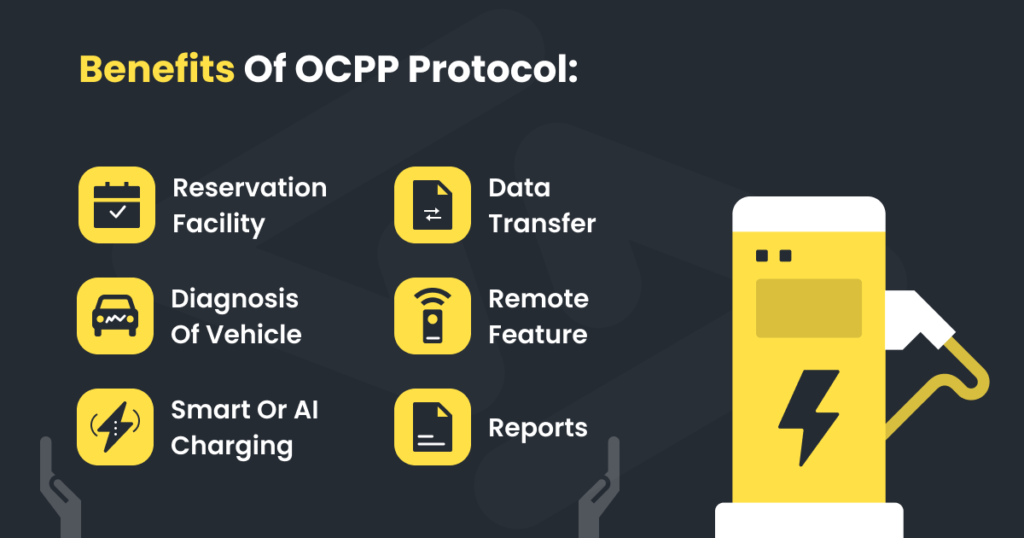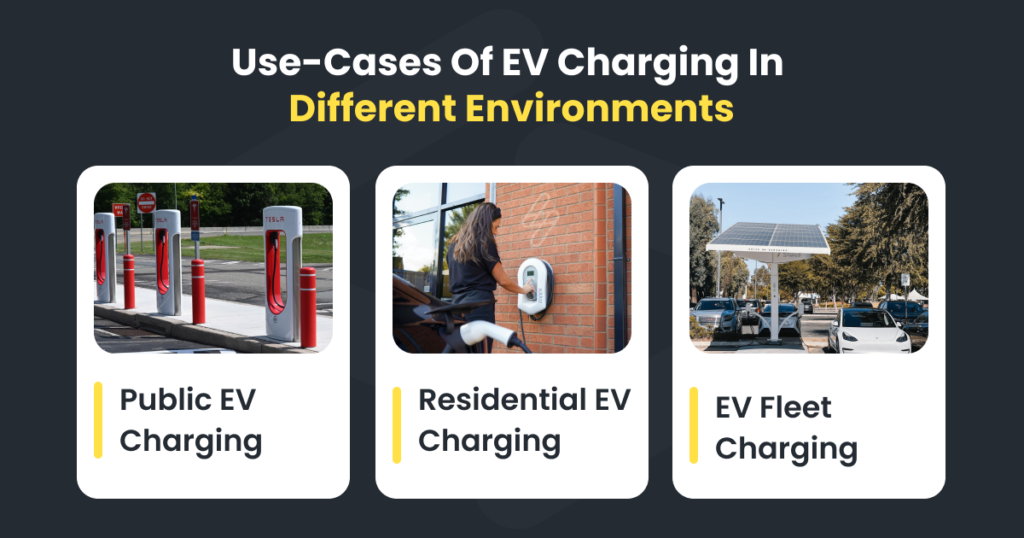Table of Contents
- What is an Electric Vehicle?
- What is the Equipment Required to Build an EV Charging App?
- How does OCPP (Open Charge Point Protocol) work for EV Charging App?
- IoT Cloud Design Service:
- How does EV charging App work?
- Implementing AWS IoT Core on EV Charging App
- Use-cases of EV Charging in Different Environments
As time passed, the demand for electric vehicles has increased. The demand for EV charging App has also increased in the global market and it is a profitable business on a global level. To fulfill this need the expenditure on EV charging stations is expected to grow from 2,115 thousand in 2020 to 30,758 thousand units in 2027 at a CARG of 46.6%.
What is an Electric Vehicle?
An electric vehicle is something that operates on an electric motor instead of combustion engines or generates power by burning a mix of fuel or gases. Therefore such types of vehicles can replace current-generation automobiles to reduce pollution. Charging of such vehicles can be done by installing hone outlets or EVSE(Electric Vehicle Supply Equipment).
Now there are Different Types of EV:
- Battery Electric Vehicle (BEV): It is a pure electric vehicle as it uses chemical energy stored in rechargeable batteries. By this there is no emission of gases hence it does not pollute the environment.
- Plug-Hybrid Electric Vehicle(PHEV): these are the hybrid vehicles that work on both i.e. electric motor and combustion engines. Most PHEVs are passenger cars but sometimes also vans and trucks etc.
- Fuel Cell Electric Vehicle(FCEV): This type of vehicle uses fuel cell sometime in combination with batteries. Generally, A fuel cell vehicle produces its energy by utilizing compressed hydrogen and environmental oxygen. Cells are not rechargeable like BEV or PHEV.
Features of the EV Charging App?
There must be these features that should be present in an EV charging app.
- It should provide a Real-time location detection facility and should provide information about nearer available charging stations.
- It must provide some basic features like scheduled charging date and time, reminders options notification panels, and a tracking system via GPS.
- It should provide real-time charging status on the application.
- There should be Feedback options that help to detect the mistakes done in-app.
- Real-time Map options should be there for finding a charging station on a trip.
- Nearer charging station should be shown by notification panel.
Read Also: How to Develop an EV Charging Station Finder App?
What is the Equipment Required to Build an EV Charging App?
The most important equipment which is required to build an EV charging app includes:
- Database: It includes MongoDB, Hbase, MySQL, Cassandra, Mail Chimp Integration, Postgress, and Redis
- Cloud Environment: AWS, Google, Azure, etc.
- Communication Protocol: OCPP
- Real-time Statics: Large Database, Spark, Cisco, Hadoop, Apache Flink
- Server: NGINX
- Framework: Laravel
- Find User Location: Google Places API, Google maps, Core London Framework
- Payments: Paypal, Braintree, Stripe, EWallets
- Notifications: Twilio, Urban Airship, Firebase Cloud Messaging, Amazon SNS
- Phone verification, MS, Voice: Twilio, Nexmo
- Front-end: ReactJS, HTML, Bootstrap, and CSS for a web application, Kotlin, Swift, Objective C for mobile applications.
- Back-end: Node JS for new microservice and review for new services Python and JavaScript.
How does OCPP (Open Charge Point Protocol) work for EV Charging App?
OCPP stands for Open Charge Point Protocol which is an application protocol that will allow communication between charging station and their management system.
When your charging station is turned on OCPP tries to connect with its management software. This management software at first verifies the identity of your charging station, after that verification, the IT backend verifies the availability or current status with the date and time by sending signals to the EV charging management system.
This process of authorization begins when you request to start the charging. It responds by unlocking the power supply nozzle which is plugged into the E-vehicle to start charging, during this OCPP sends another signal which shows that the charging process has started.
Whenever you try to stop charging, identity verification is required again in the charging station Mobile App Development.
After successful verification it sends a stoping signal to the charging station, the charging will be stopped and the user can leave.
Benefits of OCPP Protocol In EV Charging App:

- Reservation Facility: The owners or the drivers of E-Vehicle would have the advantage of reserving the place even before they reach the station just by using their mobile app.
- Diagnosis of Vehicle: It can also scan problems related to or interrupting the charging process, and can provide some tips and tricks to solve those problems yourself and quickly.
- Smart or AI charging: The charging station app can automatically decrease or increase the power being supplied to the vehicle to increase its performance.
- Data transfer: OCPP system supports different types of data transfers between mobile apps being used by the customers and EV charging stations.
- Remote Feature: EV charging App partners can manage the functionality of EV charging App remotely.
- Reports: OCPP can be used to gather complete information regarding the charging station, its current state and can report these to the system administrator.
IoT Cloud Design Service:
IoT is a significant component that is used to get an IoT solution for our EV Charging App. The design and the plan for the cloud are usually structured based on the services required in the project.
- EVSE transmits data to the cloud
- Message Queuing Telemetry (MQTT) is a protocol used to transfer data from IoT devices to IoT communication.
- These messages are sent to the MQTT broker which is responsible to designate the database by the preferences made in IoT communication.
- These cloud service providers extract data from various data processes, mostly for storage and data analytic purposes. Data analysis helps to get more insight into different charging behavior, some of the processes happen in the background and maintains the entire system or infrastructure. Data storage helps us to get long-term analysis or to study different patterns to develop and earn more.
- A database is also responsible to transfer data to API.
- API gets the data in .json format which is generally used in developing Mobile Apps.
- It validates the charging process by generating a token at the beginning.
- Once the token verifies the EVSE starts the billing-related processes.
IoT devices work with MQTT and M2M protocols for their operations. M2M devices connected with it will exchange the collected data end to end within a single network.
An EVSE should support both CAN and CCS’s PLC communication system to cover the market EV base. An IoT device is designed to carry smooth interaction with the customer’s vehicle and IoT Cloud system. Generally, Cloud providers provide SDK to build an IoT application. Our customers can plug their Electric vehicles into EVSE and can start charging with app. According to the type of plug, the IoT device will start its charging process. The device will act as an MQTT client and will communicate to IoT Cloud MQTT Broker with X.509 certificate.
- QoS 0: QoS 0 provide the fastest delivery as it transmits the message entirely at once or at all. If a connection is interrupted, messages sent will be lost as it is not stored anywhere else.
- QoS 1: QoS 1 verifies that the message is delivered. However, there is a chance that same message could be received multiple number of times.
- QoS 2: QoS 2 is the slowest but the safest quality of the Service. It uses handshaking and acknowledgment sequences to transfer messages.
How does EV charging App work?
The charging process of electric vehicles is categorized under regular charging and advanced charging processes.
Normal Charging Process:
It’s a five-step process charging process.
- If a customer decides to charge his electric vehicle and to visit a fast-charging station.
- The customer chooses a charging station from the mobile app and proceeds with the charging process of his electric vehicle.
- The customer can select from CHAdeMO or the CCS standard, based on the type of their vehicle. CCS provides AC or DC charging options through the same port, on the other hand, CHAdeMO equipped vehicles are required to have separate AC and DC charging ports.
- After the charging process completes, the customer has to select the payment option via the mobile application.
- After successful payment, the customer receives the receipt of his vehicle charging in his mobile app or via a message.
Advanced Secure Charging Process:
The advanced or standard charging process is explained from the customers’ POV. besides, the standard charging process is explained with the background activities and keeping the normal charging process running.
Implementing AWS IoT Core on EV Charging App
AWS IoT Core is a cloud service which is provided by Amazon that enables connected devices to interact securely and efficiently with cloud applications and other connected devices. It is mainly operated with HTTPS or MQTT over WSS like communication protocols.
Use-cases of EV Charging in Different Environments

EV charging comes with a compact design. the top three most important use-cases for EV Charging.
Public EV Charging: Public EV charging station prefers AC type 2 chargers, specifically for businesses, workplace, malls, and public, commercial charging. With high durability, this system is managed by centralized software. Whenever these types of stations are planted in a public place they provide plug-and-play compatibility for all the members of that society.
Residential EV Charging: If we are using an EV charging setup for residential and housing setup, we need a secure and easy integration setup. These charging exhibit almost 95% conversion efficiency and lower the total cost of ownership of battery-powered vehicles.
EV Fleet charging: EV Fleet charging solution supports all types of vehicles and charges through a DC charger. These charges are based on cutting-edge technology. These stations provide 30KW-300 KW of charging power along with the capacity of firmware and software upgrades. These stations are also integrated seamlessly with multiple payment platforms.
Conclusion:
The purpose of this article was to provide a guide in creating an IoT solution for EV charging stations used for commercial and private purposes. With IoT solutions, the EV charging App will become more efficient for EV owners and also for service providers. AWS IoT Core services help to configure, manage and develop the things like jobs, certificates, objectives, policies, rules, and other elements of an IoT solution.
If you are planning for an IoT solution with your business, we will be your best technology partner throughout your journey. We can provide you with world-class EV Charging Station Finder App development facilities and can help you to take your business to a greater success. So, utilize your opportunity to grow and turn your dreams into reality.





